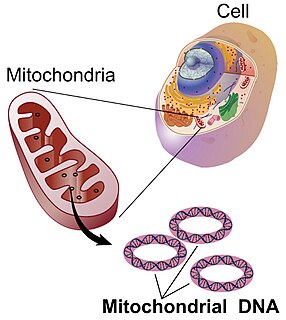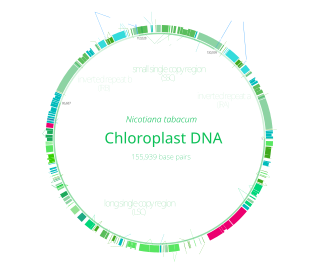Related Research Articles

Chloroplasts are organelles that conduct photosynthesis, where the photosynthetic pigment chlorophyll captures the energy from sunlight, converts it, and stores it in the energy-storage molecules ATP and NADPH while freeing oxygen from water in plant and algal cells. They then use the ATP and NADPH to make organic molecules from carbon dioxide in a process known as the Calvin cycle. Chloroplasts carry out a number of other functions, including fatty acid synthesis, much amino acid synthesis, and the immune response in plants. The number of chloroplasts per cell varies from one, in unicellular algae, up to 100 in plants like Arabidopsis and wheat.

A mitochondrion is a double membrane-bound organelle found in most eukaryotic organisms. Mitochondria generate most of the cell's supply of adenosine triphosphate (ATP), used as a source of chemical energy. Mitochondria were first discovered by Kolliker in the voluntary muscles of insects. A mitochondrion is nicknamed the "powerhouse of the cell", first coined by Philip Siekevitz in a 1957 article of the same name.

In biology, a mutation is an alteration in the nucleotide sequence of the genome of an organism, virus, or extrachromosomal DNA. Viral genomes contain either DNA or RNA. Mutations result from errors during DNA or viral replication, mitosis, or meiosis or other types of damage to DNA, which then may undergo error-prone repair, cause an error during other forms of repair, or cause an error during replication. Mutations may also result from insertion or deletion of segments of DNA due to mobile genetic elements.
An inverted repeat is a single stranded sequence of nucleotides followed downstream by its reverse complement. The intervening sequence of nucleotides between the initial sequence and the reverse complement can be any length including zero. For example, 5'---TTACGnnnnnnCGTAA---3' is an inverted repeat sequence. When the intervening length is zero, the composite sequence is a palindromic sequence.

Mitochondrial DNA is the DNA located in mitochondria, cellular organelles within eukaryotic cells that convert chemical energy from food into a form that cells can use, adenosine triphosphate (ATP). Mitochondrial DNA is only a small portion of the DNA in a eukaryotic cell; most of the DNA can be found in the cell nucleus and, in plants and algae, also in plastids such as chloroplasts.

The plastid is a membrane-bound organelle found in the cells of plants, algae, and some other eukaryotic organisms. They are considered to be intracellular endosymbiotic Cyanobacteria. Examples include chloroplasts, chromoplasts, and leucoplasts.

FtsZ is a protein encoded by the ftsZ gene that assembles into a ring at the future site of bacterial cell division. FtsZ is a prokaryotic homologue of the eukaryotic protein tubulin. The initials FtsZ mean "Filamenting temperature-sensitive mutant Z." The hypothesis was that cell division mutants of E. coli would grow as filaments due to the inability of the daughter cells to separate from one another. FtsZ is found in almost all bacteria, many archaea, all chloroplasts and some mitochondria, where it is essential for cell division. FtsZ assembles the cytoskeletal scaffold of the Z ring that, along with additional proteins, constricts to divide the cell in two.

The nucleoid is an irregularly shaped region within the prokaryotic cell that contains all or most of the genetic material. The chromosome of a prokaryote is circular, and its length is very large compared to the cell dimensions needing it to be compacted in order to fit. In contrast to the nucleus of a eukaryotic cell, it is not surrounded by a nuclear membrane. Instead, the nucleoid forms by condensation and functional arrangement with the help of chromosomal architectural proteins and RNA molecules as well as DNA supercoiling. The length of a genome widely varies and a cell may contain multiple copies of it.
Heteroplasmy is the presence of more than one type of organellar genome within a cell or individual. It is an important factor in considering the severity of mitochondrial diseases. Because most eukaryotic cells contain many hundreds of mitochondria with hundreds of copies of mitochondrial DNA, it is common for mutations to affect only some mitochondria, leaving most unaffected.

Homoplasmy is a term used in genetics to describe a eukaryotic cell whose copies of mitochondrial DNA are all identical. In normal and healthy tissues, all cells are homoplasmic. Homoplasmic mitochondrial DNA copies may be normal or mutated; however, most mutations are heteroplasmic. It has been discovered, though, that homoplasmic mitochondrial DNA mutations may be found in human tumors.

Human mitochondrial genetics is the study of the genetics of human mitochondrial DNA. The human mitochondrial genome is the entirety of hereditary information contained in human mitochondria. Mitochondria are small structures in cells that generate energy for the cell to use, and are hence referred to as the "powerhouses" of the cell.
Nuclear DNA(nDNA), or nuclear deoxyribonucleic acid, is the DNA contained within each cell nucleus of a eukaryotic organism. It encodes for the majority of the genome in eukaryotes, with mitochondrial DNA and plastid DNA coding for the rest. It adheres to Mendelian inheritance, with information coming from two parents, one male and one female—rather than matrilineally as in mitochondrial DNA.
A nuclear gene is a gene located in the cell nucleus of a eukaryote. The term is used to distinguish nuclear genes from the genes of the endosymbiotic organelle, that is genes in the mitochondrion, and in case of plants and algae, the chloroplast, which host their own genetic system and can produce proteins from scratch. A nuclear gene is just one of the genetic building blocks of a eukaryotic organism's entire genome.
Extrachromosomal DNA is any DNA that is found off the chromosomes, either inside or outside the nucleus of a cell. Most DNA in an individual genome is found in chromosomes contained in the nucleus. Multiple forms of extrachromosomal DNA exist and serve important biological functions, e.g. they can play a role in disease, such as ecDNA in cancer.
Extranuclear inheritance or cytoplasmic inheritance is the transmission of genes that occur outside the nucleus. It is found in most eukaryotes and is commonly known to occur in cytoplasmic organelles such as mitochondria and chloroplasts or from cellular parasites like viruses or bacteria.
NUMT, pronounced "new might," is an acronym for "nuclear mitochondrial DNA" segment coined by evolutionary geneticist, Jose V. Lopez, which describes a transposition of any type of cytoplasmic mitochondrial DNA into the nuclear genome of eukaryotic organisms.
In molecular biology, a displacement loop or D-loop is a DNA structure where the two strands of a double-stranded DNA molecule are separated for a stretch and held apart by a third strand of DNA. An R-loop is similar to a D-loop, but in this case the third strand is RNA rather than DNA. The third strand has a base sequence which is complementary to one of the main strands and pairs with it, thus displacing the other complementary main strand in the region. Within that region the structure is thus a form of triple-stranded DNA. A diagram in the paper introducing the term illustrated the D-loop with a shape resembling a capital "D", where the displaced strand formed the loop of the "D".
The CoRR hypothesis states that the location of genetic information in cytoplasmic organelles permits regulation of its expression by the reduction-oxidation ("redox") state of its gene products.
Uniparental inheritance is a non-mendelian form of inheritance that consists of the transmission of genotypes from one parental type to all progeny. That is, all the genes in offspring will originate from only the mother or only the father. This phenomenon is most commonly observed in eukaryotic organelles such as mitochondria and chloroplasts. This is because such organelles contain their own DNA and are capable of independent mitotic replication that does not endure crossing over with the DNA from another parental type. Although uniparental inheritance is the most common form of inheritance in organelles, there is increased evidence of diversity. Some studies found doubly uniparental inheritance (DUI) and biparental transmission to exist in cells. Evidence suggests that even when there is biparental inheritance, crossing-over doesn't always occur. Furthermore, there is evidence that the form of organelle inheritance varied frequently over time. Uniparental inheritance can be divided into multiple subtypes based on the pathway of inheritance.

Chloroplast DNA (cpDNA) is the DNA located in chloroplasts, which are photosynthetic organelles located within the cells of some eukaryotic organisms. Chloroplasts, like other types of plastid, contain a genome separate from that in the cell nucleus. The existence of chloroplast DNA was identified biochemically in 1959, and confirmed by electron microscopy in 1962. The discoveries that the chloroplast contains ribosomes and performs protein synthesis revealed that the chloroplast is genetically semi-autonomous. The first complete chloroplast genome sequences were published in 1986, Nicotiana tabacum (tobacco) by Sugiura and colleagues and Marchantia polymorpha (liverwort) by Ozeki et al. Since then, hundreds of chloroplast DNAs from various species have been sequenced.
References
- ↑ Russell, P. J. 2002. iGenetics.Benjamin Cummings, San Francisco
- 1 2 Kasamatsu, Harumi; Robberson, Donald L.; Vinograd, Jerome (1971). "A novel closed-circular mitochondrial DNA with properties of a replicating intermediate". Proceedings of the National Academy of Sciences. 68 (9): 2252–2257. doi: 10.1073/pnas.68.9.2252 . PMC 389395 . PMID 5289384.
- 1 2 Nicholls, Thomas J.; Minczuk, Michal (2014). "In D-loop: 40 years of mitochondrial 7S DNA". Experimental Gerontology. 56: 175–181. doi:10.1016/j.exger.2014.03.027. PMID 24709344. S2CID 140205074.
- ↑ Doda, Jackie N.; Wright, Catharine T.; Clayton, David A. (1981). "Elongation of displacement-loop strands in human and mouse mitochondrial DNA is arrested near specific template sequences". Proceedings of the National Academy of Sciences. 78 (10): 6116–6120. doi: 10.1073/pnas.78.10.6116 . PMC 348988 . PMID 6273850.
- ↑ Clayton, David A (1982). "Replication of animal mitochondrial DNA". Cell. 28 (4): 693–705. doi:10.1016/0092-8674(82)90049-6. PMID 6178513. S2CID 12682150.
- ↑ Chang, D. D.; Clayton, D. A. (1985-01-01). "Priming of human mitochondrial DNA replication occurs at the light-strand promoter". Proceedings of the National Academy of Sciences. 82 (2): 351–355. doi: 10.1073/pnas.82.2.351 . ISSN 0027-8424. PMC 397036 . PMID 2982153.
- ↑ Leslie, Mitch (2007-01-15). "Thrown for a D-loop". The Journal of Cell Biology. 176 (2): 129a. doi:10.1083/jcb.1762iti3. ISSN 0021-9525. PMC 2063944 .
- ↑ He, Jiuya; Mao, Chih-Chieh; Reyes, Aurelio; Sembongi, Hiroshi; Re, Miriam Di; Granycome, Caroline; Clippingdale, Andrew B.; Fearnley, Ian M.; Harbour, Michael (2007-01-15). "The AAA+ protein ATAD3 has displacement loop binding properties and is involved in mitochondrial nucleoid organization". The Journal of Cell Biology. 176 (2): 141–146. doi:10.1083/jcb.200609158. ISSN 0021-9525. PMC 2063933 . PMID 17210950.
- ↑ Fish, Jennifer; Raule, Nicola; Attardi, Giuseppe (2004-12-17). "Discovery of a Major D-Loop Replication Origin Reveals Two Modes of Human mtDNA Synthesis" (PDF). Science. 306 (5704): 2098–2101. doi:10.1126/science.1102077. ISSN 0036-8075. PMID 15604407. S2CID 36033690.
- ↑ Burger; et al. (2003). "Unique mitochondrial genome architecture in unicellular relatives of animals". PNAS. 100 (3): 892–897. doi: 10.1073/pnas.0336115100 . PMC 298697 . PMID 12552117.
- ↑ Fernández-García, J. L.; Carranza, J.; Martínez, J. G.; Randi, E. (2014-03-01). "Mitochondrial D-loop phylogeny signals two native Iberian red deer (Cervus elaphus) Lineages genetically different to Western and Eastern European red deer and infers human-mediated translocations". Biodiversity and Conservation. 23 (3): 537–554. doi:10.1007/s10531-013-0585-2. ISSN 0960-3115. S2CID 14719183.
- ↑ Silva; et al. (2016). "Genetic diversity analysis of major Sri Lankan goat populations using microsatellite and mitochondrial DNA D-loop variations". Small Ruminant Research. 148: 51–61. doi:10.1016/j.smallrumres.2016.12.030. hdl: 11449/178557 .